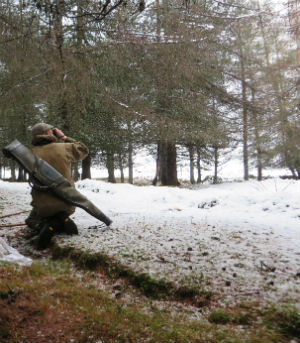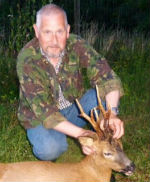Senior CIC International Trophy Judge Iain Watson weighs up the challenges involved in deer counting and the winter deer cull.
When I started stalking, for me, and many recreational Roe stalkers winter culling particularly on low ground, was a matter of taking advantage of breaks in the weather and extracting a toll of the surplus females and young that were required for home consumption. Usually this was done with the cover at its lowest and the deer at their most visible. No doubt there were always limitations to this. The need to operate within the limits imposed by other sporting and rural users, be they game shooters farmers or foresters, meant that culling was often restricted to short windows in the late winter period.
Handling and lardering shot deer at home without causing apoplexy to aged relatives and anxious neighbours could and did lead to tricky situations. I well remember helping to carry roe carcasses into a garage temporarily in use as a larder on a housing estate in West Fife, all seemed to be progressing well till the police charged into the garage to investigate a report that two men had been seen removing large dead dogs from the back of a land rover. Fortunately the evidence swinging from three gambrels mitigated against the claim, but it taught me a lesson about discretion and communication!
(Above: As winter progresses deer typically migrate to the low ground)
But times and circumstances move on, and change does impact on all aspects of our sporting lives. Take our current winter, the warmest December on record, but with storms and devastating floods in the North, balmy days and unseasonal temperatures further south. Both man and wildlife are affected, for deer with the grass still green and growing, and an excess of remaining fodder and cover in low ground woods, forage activities and feeding patterns have altered. Animals confronted with an abundance of food in secure settings are not as likely to expose themselves to risk in the open. In response to this our habits must similarly adjust.
While these environmental changes in themselves present new challenges for the stalker, they come at a time of continued expansion in the populations of all our deer species coupled with the rise in stalker numbers and training, and the ever growing "professionalisation" of the recreational stalker. All this has led to us developing a culture of deer management, and with it a shift in the way that many of us have had to make in our approach to winter culling.
Key to any cull plan has to be censusing and understanding the structure of the local deer population. Counting needs to become a regular feature through the deer year. An obvious statement I hear you think, indeed so, but how many of us chuck it and chance it every year, and operate on the basis that "if five was good last year it'll work this year". Planned counting not only allows us to build up a season by season understanding of the population but also shows feeding patterns and times, as well as changing preferences based on food availability and feeding security. As far as our key low ground species of roe and fallow are concerned counting has always been at its easiest in late winter. With both species pushed in groups and into the open, visual counts and an estimate of the demography of the population is possible. If we add to this technology in the way of trail cams and night vision equipment theoretically at least we should get enough information to estimate our overall population and critically the number of breeding females. At the same time it allows the watcher to identify how animals use their home ranges and how they chose to exit and return to cover which aids culling plans when the time comes.

Hopefully by now most of us acknowledge that the way to manage our deer is through the effective control of the female population. This it can be argued is particularly relevant to Roe with their tendency towards twin births, and ability to reproduce at a young age. If we exclude from our thinking our small invasive newcomers, Roe it could be argued currently present the biggest challenge in managing our indigenous and long established species.
With deer, as in life, it's often said that there is nothing new in the world, though we don't always recognise that. Current thinking rightly places much faith in managing doe culls through organized moves to waiting rifles. In essence it's not really very different to the infamous Roe drives beloved of the shooters of yesteryear, when worthies with shotguns blazed away at anything which came "through the line" or indeed of some practices from much further back in time. Certainly today's incarnation should be much more selective in terms of what is targeted and how the process is controlled.
When planning an organised cull involving moving deer to waiting rifles two key aspects need to be to the fore. The main one being safety, not only of all the participants involved but also of any others who may intentionally or otherwise stray into the action. Safe shooting is best done from highseats, and these need to be positioned to have a safe arc of fire and not conflict with neighbours.
Communication between seated rifles and those tasked with moving the deer has to be in place, have been tested, and has to work. Above all Guns need to be well briefed not only about the plan but also about what can and can't be shot. Start and stop signals must to be clear, understood, and adhered to. For the benefit of non participants, due warning by way of signs and closures should be in place. The second aspect concerns stress, not only as it impacts on the deer but also how it affects the shooters. A perception which sometimes exists on the part of shooters on organised cull days is that shots have to be taken at all costs. It's important to address this as it can lead to anxiety and competition among guns, leading to shots being taken which cause wounding or a misidentification resulting in animals being killed out of season. For the deer, stress can best kept to a minimum by a well planned and executed move with as little disturbance and drama as possible negating the need for either a number of repeat performances or worse stressed animals being chased round and round to waiting guns.
A good winter culling program should be a blend of techniques, which takes advantage of all of the resources available to the stalker, makes use of the weather conditions, and aims to achieve the required cull figure by a target date. If there are shortfalls then the option of single handed stalking remains to pick up the required numbers. After that it's back to counting and watching, planning for the next season, before the Bucks begin as the days lengthen.

If you'd like to read more from Iain follow this link to a recent article in which he considers rifle calibres: choosing-the-right-calibre





















